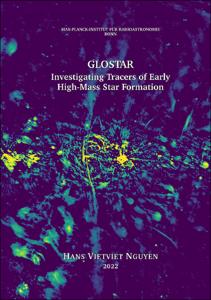GLOSTARInvestigating Tracers of Early High-Mass Star Formation

GLOSTAR
Investigating Tracers of Early High-Mass Star Formation

| dc.contributor.advisor | Menten, Karl M. | |
| dc.contributor.author | Nguyen, Hans Vietviet | |
| dc.date.accessioned | 2023-05-12T08:35:45Z | |
| dc.date.available | 2023-05-12T08:35:45Z | |
| dc.date.issued | 12.05.2023 | |
| dc.identifier.uri | https://hdl.handle.net/20.500.11811/10835 | |
| dc.description.abstract | High-mass stars (>8 msol) are not as numerous as their less massive counterparts but have a much more profound impact on their environment within their native galaxies. Despite their importance, our understanding of their formation process is not as developed as that of low-mass stars. As such, the GLObal view on STAR formation (GLOSTAR) Galactic Plane survey aims to address this question of how high-mass stars form by finding all sites of high-mass star formation at different evolutionary stages in the Milky Way and characterising their physical properties in order to develop a complete view of massive star formation.
In the first part of this thesis, I present our findings of 5.8 GHz radio continuum observations of the region known as the Central Molecular Zone (CMZ) using the Karl G. Jansky Very Large Array (VLA) to detect HII regions, which are known tracers of high-mass star formation. We investigated the presence of young stellar object (YSO) candidates with HII regions as it is unknown how many of the near-infrared (NIR) identified YSOs trace HII regions. Our results show that the majority of these NIR-identified YSOs lack VLA radio counterparts. We found that most of these sources also lack dust emission (using data from ATLASGAL), and it is likely that they are older and have dispersed their natal clouds. The second part of this thesis focuses on 6.7 GHz methanol masers as they have been shown to be an exclusive tracer of the earliest stages of high-mass star formation. Many surveys have already been conducted, however, with the upgraded VLA, GLOSTAR can provide the most sensitive unbiased survey of 6.7 GHz methanol masers to date. I present the results of this catalogue where we detect many new masers. To study the environments of early high-mass star formation we used ancillary dust continuum and radio continuum data. We find that the newly detected masers are more likely to be associated with less massive stars. Furthermore, by comparing the radio source and the maser flux distributions, we find no correlation with respect to angular offset, suggesting that the maser and the radio source are powered by unrelated mechanisms. Given that the data taken for GLOSTAR was obtained using both the D-configuration and B-configuration of the VLA, the final part of this thesis focuses on the addition of the higher resolution data to a subset of the methanol masers. The higher resolution of the B-configuration allows for the distinction of multiple masers from a given maser in the D-configuration and provides better positional accuracy of the maser. Additionally, the access to two epochs of observations allows us to study the time variability of the maser emission. We produce a catalogue for the pilot region of GLOSTAR with improved positions for the 6.7 GHz methanol masers. We also compared the brightness variation for the main velocity peaks between the D-configuration and B-configuration observations and produced a catalogue of potential variable masers. | en |
| dc.language.iso | eng | |
| dc.rights | Namensnennung 4.0 International | |
| dc.rights.uri | http://creativecommons.org/licenses/by/4.0/ | |
| dc.subject | Radio astronomy | |
| dc.subject | interferometry | |
| dc.subject | methanol maser | |
| dc.subject | high mass star formation | |
| dc.subject | molecular clouds | |
| dc.subject.ddc | 500 Naturwissenschaften | |
| dc.subject.ddc | 520 Astronomie, Kartografie | |
| dc.subject.ddc | 530 Physik | |
| dc.title | GLOSTAR | |
| dc.title.alternative | Investigating Tracers of Early High-Mass Star Formation | |
| dc.type | Dissertation oder Habilitation | |
| dc.publisher.name | Universitäts- und Landesbibliothek Bonn | |
| dc.publisher.location | Bonn | |
| dc.rights.accessRights | openAccess | |
| dc.identifier.urn | https://nbn-resolving.org/urn:nbn:de:hbz:5-70809 | |
| dc.relation.doi | https://doi.org/10.1051/0004-6361/202140802 | |
| dc.relation.doi | https://doi.org/10.1051/0004-6361/202244115 | |
| ulbbn.pubtype | Erstveröffentlichung | |
| ulbbnediss.affiliation.name | Rheinische Friedrich-Wilhelms-Universität Bonn | |
| ulbbnediss.affiliation.location | Bonn | |
| ulbbnediss.thesis.level | Dissertation | |
| ulbbnediss.dissID | 7080 | |
| ulbbnediss.date.accepted | 18.04.2023 | |
| ulbbnediss.institute | Angegliederte Institute, verbundene wissenschaftliche Einrichtungen : Max-Planck-Institut für Radioastronomie (MPIfR) | |
| ulbbnediss.fakultaet | Mathematisch-Naturwissenschaftliche Fakultät | |
| dc.contributor.coReferee | Kroupa, Pavel | |
| ulbbnediss.contributor.orcid | https://orcid.org/0000-0003-2524-7790 | |
| ulbbnediss.contributor.gnd | 1292269111 |
Dateien zu dieser Ressource
Das Dokument erscheint in:
-
E-Dissertationen (4405)




